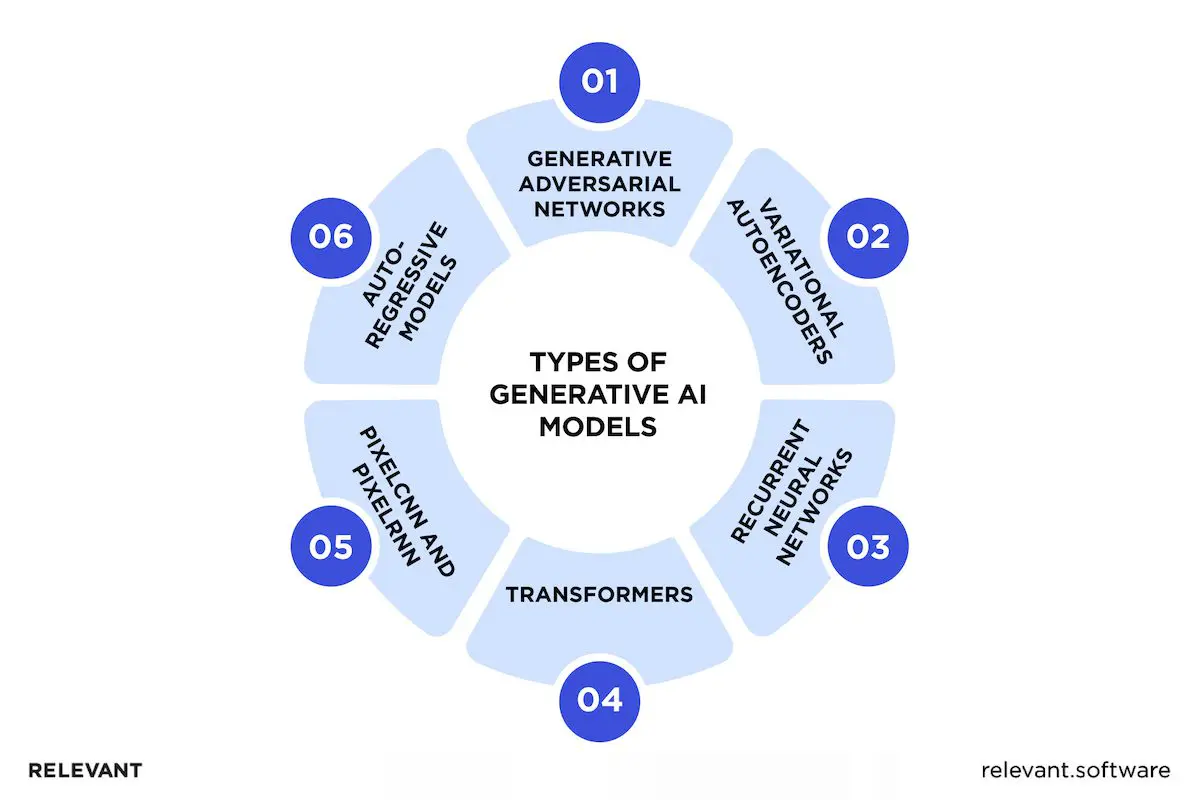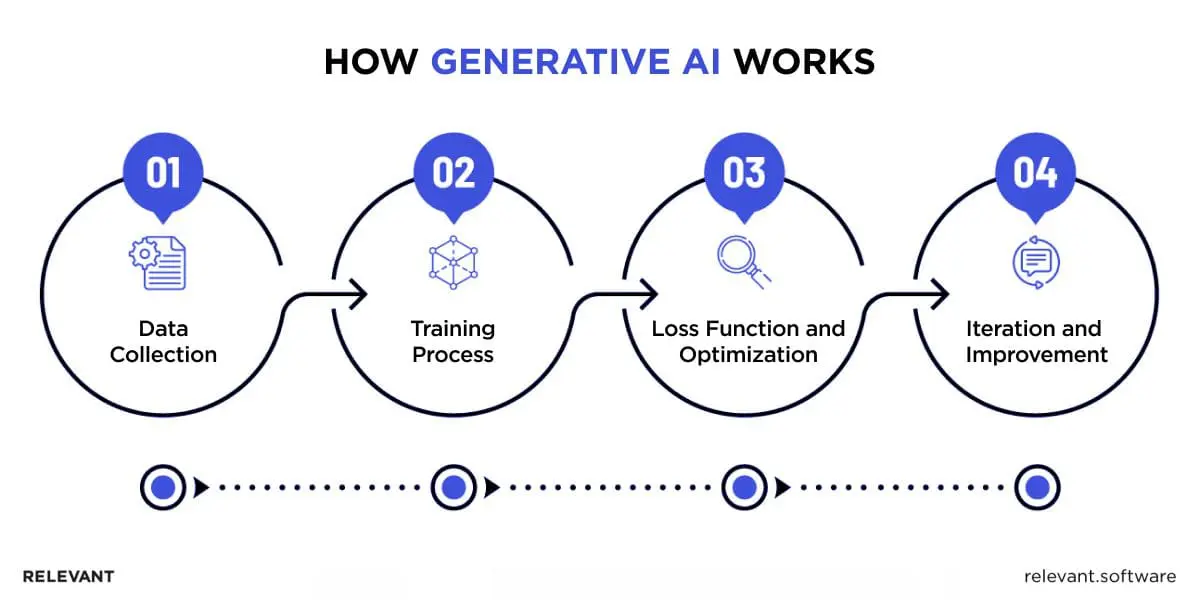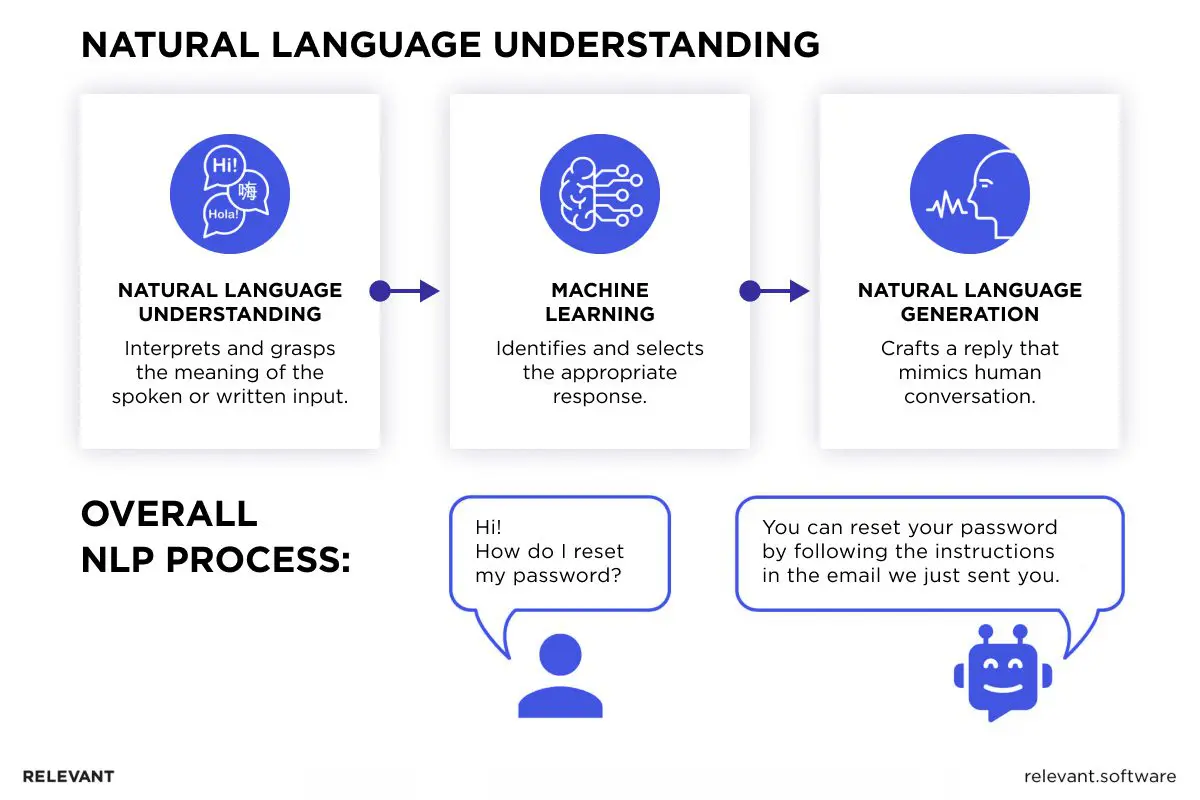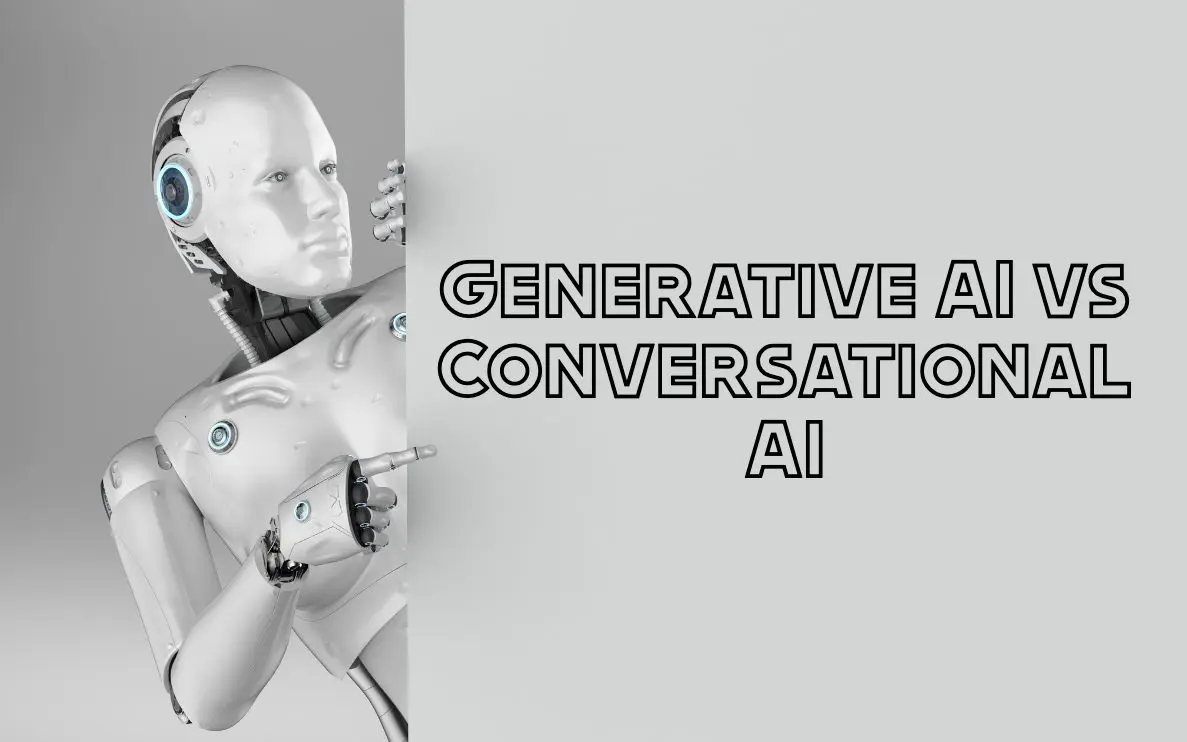The Battle of Titans: Generative vs. Conversational AI

Right now, two of the hottest technologies in the innovation sphere are Conversational AI and Generative AI. Despite their similar names, they differ greatly in their uses and foundational principles. If you aim to invest in AI development services, knowing these differences will help you maximize your technology budget. Therefore, we’ll break down Generative AI vs Conversational AI, provide specifics, and show you the practical uses of both technologies. By the end, you’ll appreciate how these AI types shape the future.
What is Generative AI?
Generative AI is a remarkable frontier in artificial intelligence, where the focus shifts from pattern recognition and prediction to the creation of entirely new content inspired by, rather than directly derived from, the input data.
At its heart, generative AI utilizes a type of machine learning (ML) called unsupervised or semi-supervised learning, where models learn patterns and structures from large datasets without explicit instructions on what to do with that data. The difference between generative AI vs machine learning lies in GenAI’s ability to produce new outputs from learned patterns, whereas ML predicts outcomes based on data.
Types of Generative AI Models
Generative AI encompasses a variety of models, each designed to create new content in a unique way. Here are some of the most prominent types:

Generative Adversarial Networks (GANs):
GANs utilize two neural networks: one generator and one discriminator. The generator strives to produce data that appears genuine, whereas the discriminator’s task is to detect any differences. This adversarial process enables the generator to improve its outputs over time, ultimately producing highly realistic results.
Variational Autoencoders (VAEs):
VAEs are designed to learn the underlying distribution of input data and generate new samples from this distribution. They achieve this by encoding the input data into a latent space, essentially a compressed version of the data. This latent space is then used to decode and generate new, similar data.
Recurrent Neural Networks (RNNs) and Long Short-Term Memory Networks (LSTMs):
RNNs and LSTMs are specialized neural networks designed to excel with sequential data like text and time series. They can build contextually accurate sequences by learning patterns from the training data. RNNs are well-suited for tasks that require the context of previous data points, while LSTMs improve this ability by handling long-term dependencies effectively.
Transformers:
Like GPT-3 models, they have transformed natural language processing (NLP). These models utilize self-attention mechanisms to grasp the context and relationships between words in a piece of text, which enables them to produce highly coherent and contextually appropriate content. Transformers are versatile and find applications in various tasks, as well as text generation, translation, and summarization, which makes them indispensable tools in the AI toolkit.
PixelCNN and PixelRNN:
These models are specifically designed for image generation. They create images one pixel at a time, with each pixel influenced by the ones that came before it. This method enables them to produce incredibly detailed and lifelike images. PixelCNN and PixelRNN are often used in tasks like image completion and super-resolution.
Auto-Regressive Models:
Auto-regressive models predict the next value in a sequence from the previous values. They build sequences one step at a time, and they ensure that the generated data follows the learned patterns closely. This makes them especially useful for forecasting time series data and text generation tasks.
Each of these generative AI models excels in its own way and is best suited for specific kinds of creative tasks. The difference between AI and generative AI highlights generative AI’s unique capability to invent new data, setting it apart from broader AI applications.
How Generative AI Works
The difference between AI and generative AI is its purpose: generative AI creates, while standard AI processes and interprets. Here, we look at the basic principles of how GenAI models are trained and the types of data they require.

- Data Collection: For generative AI models to be effective, they need a substantial amount of high-quality data to learn from. For example, if the aim is to generate text, you must train the model on an extensive collection of written material.
- Training Process: The process involves feeding the data into the model so it can learn patterns and relationships within the data. The model uses these patterns to understand how to create new content. It is typically done through neural networks that mimic how the human brain processes information.
- Loss Function and Optimization: The model’s output is compared to the actual data throughout training, and a loss function measures the difference. The goal is to minimize this difference through optimization techniques when the model improves its output gradually.
- Iteration and Improvement: The model goes through many iterations, continually adjusting its parameters to match the training data’s patterns better. This iterative process helps the model generate more accurate and realistic content over time.
Data Requirements:
- Quality: The data must be high quality to ensure the model learns the correct patterns and structures.
- Quantity: A large volume of data is necessary to give the model enough examples to learn from.
- Diversity: Diverse data helps the model generalize better and produce varied outputs.
Generative AI: Key Applications and Examples of Generative Process
Generative AI is a versatile technology with numerous applications across various fields. These are the primary areas where its strengths are most evident:
Content Creation
The key difference between AI and generative AI is that Gen AI focuses on content creation.
1. Text Generation
The model learns language patterns, grammar, and context from the training data. It can then generate new text that is coherent and contextually relevant, useful for applications like chatbots and content creation.
- Example: AI-powered assistants like GPT-3 can generate articles, stories, and reports. These tools help writers through suggestions, sentence completion, or even entire paragraph writing.
- Application: They are utilized in content marketing, blogging, and journalism to produce top-notch written content quickly and efficiently.
2. Image Generation
The model analyzes features like shapes, colors, and textures. It can create new images that resemble the training data, which is useful for art generation, design, and enhancing photos.
- Example: Tools like DALL-E can create unique images from textual descriptions. Artists and designers use these AI models to generate original artwork, illustrations, and design concepts.
- Application: They are widely applied in graphic design, advertising, and digital art to produce visually appealing content quickly.
3. Video Generation
A generative AI model can create realistic video content by learning from existing video data.
- Example: Deepfake technology can produce convincing videos of people doing or saying things they never did, as seen in deepfake videos of famous actors. AI is also used for special effects in movies, such as the realistic aging or de-aging of characters in films.
- Application: These capabilities are widely used in entertainment, marketing, and media to produce video content and special effects.
4. Music Generation
The model learns patterns in melodies, harmonies, and rhythms. It can then compose new music pieces that mimic the style of the training data.
- Example: AI models like OpenAI’s MuseNet can compose music in various styles and genres. Musicians and producers use these tools to create new melodies and harmonies.
- Application: Applied in music production, background scores for films, and creating royalty-free music tracks.
Simulation and Modeling
Generative AI can replicate real-world scenarios for training and research. This ability is vital for crafting controlled environments where systems can be tested and refined without the risks of actual real-world testing.
- Example: AI models can create virtual environments for autonomous vehicle testing or simulate medical procedures for healthcare professionals’ education.
- Application: They are used in fields like autonomous driving, aerospace, healthcare, and urban planning to create realistic simulations for testing, training, and research.
Data Augmentation and Anonymization
Generative AI vs. machine learning is a hot topic, especially in fields like data augmentation and anonymization, where content creation and data analysis are crucial.
Data Augmentation
Data Augmentation applies techniques to multiply the diversity and volume of data for ML training without sourcing new data. By transforming existing data, data augmentation helps improve model performance, robustness, and generalization capabilities.
- Example: AI can simulate real-world data by generating synthetic datasets, which is extremely helpful when it’s tough to gather large amounts of real data.
- Application: This method improves ML models in tasks such as image recognition, language comprehension, and prediction by providing them with more data for learning.
Data Anonymization
Data Anonymization transforms personal data to prevent identification. It ensures privacy by removing or encrypting identifiable information while retaining the data’s usability for analysis.
- Example: Generative AI fabricates anonymized datasets that uphold the statistical aspects of the original data yet exclude personal details. That helps maintain privacy while allowing data analysis.
- Application: This technology is utilized in healthcare, finance, and any industry where data privacy is crucial. It enables organizations to share and analyze data strictly, adhering to individual privacy.
Generative AI’s capacity to produce and modify data unlocks a wealth of opportunities across various sectors. It enhances creative workflows, refines simulations, and even bolsters data privacy.
Advancements in Generative AI
Generative AI has made great strides and can now produce highly realistic and imaginative outputs. Discover the latest milestones in this revolutionary technology.
| Milestone | Description | Impact |
| 2013 – Development of VAEs | Kingma and Welling introduced Variational Autoencoders (VAEs). | Provided a robust framework for data generation, useful in image and music generation. |
| 2014 – Introduction of GANs | Ian Goodfellow and his team introduced Generative Adversarial Networks (GANs) | Revolutionized AI by enabling the creation of highly realistic images, videos, and other data types. |
| 2017 -Transformer Models | Vaswani et al. introduced the Transformer architecture. | Dramatically improved natural language understanding and generation, leading to models like GPT-3. |
| 2018 – BERT | Google introduced BERT (Bidirectional Encoder Representations from Transformers). | Enhanced the accuracy of search engines and NLP applications by understanding word context. |
| 2018-2020 – StyleGAN | NVIDIA developed StyleGAN and its iterations. | Achieve new heights in image synthesis, producing highly detailed and customizable images |
| 2020 – GPT-3 | OpenAI introduced GPT-3, a language model with 175 billion parameters. | Showed unprecedented abilities in human-like text generation and grasping context. |
| 2021 – DALL-E, CLIP and Codex | OpenAI introduced DALL-E and CLIP, which generate images from text and understand image content, along with Codex, an AI system for code generation. | Demonstrated multimodal AI potential and powers GitHub Copilot for efficient code writing. |
The uses of generative AI are broad and ever-growing. Understanding the difference between AI and generative AI enables businesses to choose the best tools for both creative and analytical needs.
What is Conversational AI?
So, in easy-to-understand language, what is Conversational AI? It is an advanced technology that facilitates dynamic and interactive dialogue between machines and humans. Its main objective is to comprehend user queries and deliver relevant, conversational responses. This type of AI powers chatbots and voice assistants and enables them to engage in natural dialogue with users.
While it does generate text or speech as part of its function, the emphasis is on interaction and contextually appropriate responses rather than creating new content.
Technologies Behind Conversational AI
Behind every sophisticated AI system is a suite of powerful technologies. This section delves into the tech components that make these systems so effective.

Natural Language Processing (NLP):
At the core of conversational AI lies NLP, which enables machines to understand and generate human language. NLP involves several subfields:
- Tokenization: Breaks down text into manageable pieces, typically words or phrases.
- Part-of-Speech Tagging: Determines the grammatical elements within a sentence.
- Named Entity Recognition: Detects and classifies key entities such as names, dates, and places.
- Dependency Parsing: Analyzes grammatical structure and the relationships between words.
Machine Learning (ML) and Deep Learning (DL):
ML and DL are fundamental to conversational AI, enabling it to analyze large datasets and improve progressively. These technologies allow the AI to detect patterns, grasp context, and produce suitable responses.
- Supervised Learning: It employs labeled data to train models in outcome prediction.
- Unsupervised Learning: It helps find patterns and structures within data without labeled inputs.
- Reinforcement Learning: It improves model performance through trial and error interactions.
Neural Networks:
Neural networks, particularly deep neural networks, are pivotal in powering conversational AI. These networks mimic the human brain’s architecture and function through interconnected layers of nodes (neurons).
- Recurrent Neural Networks (RNNs): They are suitable for sequence prediction tasks and crucial for understanding conversation context.
- Transformers: Advanced models like BERT and GPT can understand and generate human language by simultaneously processing entire sentences or paragraphs.
Speech Recognition and Synthesis:
For voice-based AI systems, speech recognition and synthesis technologies are essential.
- Automatic Speech Recognition (ASR): It translates spoken language into text. Technologies such as Google’s ASR and Apple’s Siri employ sophisticated models to achieve high accuracy.
- Text-to-Speech (TTS): This technology converts text back into spoken language, which allows AI to communicate in a natural and human-like voice. Solutions like Amazon Polly and Google Text-to-Speech are leading in this space.
Related – How to create an AI

Common Use Cases of Conversational AI
Conversational AI tools have become increasingly prevalent across various industries because they can emulate human-like interactions and offer immediate, efficient support. Below are some of the most common applications:
Customer Service
With Conversational AI, businesses are now able to offer more efficient and personalized customer service. Let’s see how.
1. Automated Support
Conversational AI models understand customer queries and provide instant, accurate responses. These systems are trained on extensive datasets that include real-life customer interactions, which enables them to handle a wide range of inquiries.
- Example: Chatbots on e-commerce websites assist customers with product searches, order tracking, and returns processing.
- Application: These models are used in customer service departments to provide 24/7 support, reduce wait times, and improve customer satisfaction.
2. Virtual Assistants
AI-powered assistants handle scheduling, reminders, and answering questions. They leverage NLP to communicate effectively with users.
- Example: Amazon Alexa and Google Assistant help users set reminders, play music, and manage smart home devices.
- Application: Conversation bots enhance user convenience and interaction in smart home systems, personal productivity tools, and customer service.
Healthcare
Through advanced technologies, these AI systems can offer personalized support and valuable medical insights and ultimately improve the overall healthcare experience for patients and providers. Conversational AI brings numerous benefits to healthcare, such as:
1. Better Patient Care
AI can assess symptoms, deliver medical information, and remind patients to take their medications. These systems, trained on extensive medical datasets, provide dependable support.
- Example: AI health assistants like Babylon Health provide symptom checking, medical advice, and appointment scheduling.
- Application: These systems are implemented in telemedicine and healthcare frameworks to ensure patients have easier access to health information and services.
2. Mental Health Support
AI-driven chatbots offer emotional support and mental health resources. They can engage in conversations that help users manage stress, anxiety, and depression.
- Example: Through conversational CBT techniques, Woebot helps users cope with and improve their mental health.
- Application: AI-enabled chatbots are utilized in mental health apps and online therapy services to provide accessible support.
Finance
These AI-driven solutions provide efficient, personalized interactions, which help financial institutions meet their clients’ needs.
1. Customer Assistance
Conversational AI assists customers with financial transactions, account inquiries, and personalized financial advice. These systems use secure data handling to ensure privacy.
- Example: Bank chatbots like Erica by Bank of America help users check balances, transfer money, and manage finances.
- Application: Such assistants are employed in banking and financial services to enhance customer service and streamline operations.
2. Fraud Detection
AI systems analyze transaction data to identify and prevent fraudulent activities. They interact with customers to verify transactions and alert them to potential fraud.
- Example: AI chatbots in banking apps alert users to unusual activity and verify the authenticity of transactions.
- Application: They are used in financial security systems to protect users and prevent fraud.
Retail and E-commerce
These AI-powered systems enable businesses to engage with customers more effectively, boost sales, and enhance satisfaction. Here are the benefits of AI in e-commerce:
1. Customized Shopping
Conversational AI offers product recommendations based on user preferences and purchase history to improve the overall customer experience.
- Example: On retail websites, AI chatbots recommend products, address customer inquiries, and assist with order completion.
- Application: Conversation systems are used in online shopping platforms to increase sales and improve customer engagement.
2. Order Management
Conversation AI systems handle order inquiries, track shipments, and manage returns, providing a seamless shopping experience.
- Example: E-commerce chatbots provide order status updates and process return requests.
- Application: Conversation chatbots are employed in retail customer service to streamline order management and enhance user satisfaction.
Education
These intelligent technologies support both – students and teachers and make the education processes more effective and reachable.
1. Personalized Tutors
Conversational helpers offer customized learning experiences, which assist students with homework, explain concepts, and provide study resources.
- Example: Take Duolingo; it uses AI to guide users through interactive language learning sessions.
- Application: These systems are used in educational apps and platforms to support personalized learning and improve academic outcomes.
2. Administrative Assistance
Conversational AI chatbots assist with enrollment, schedule management, and administrative questions, which make educational administration more efficient.
- Example: University chatbots help students with enrollment processes and provide information about courses and schedules.
- Application: Such smart tools are utilized in educational institutions to improve administrative efficiency and student support.
Conversational AI’s ability to understand and engage in human-like interactions makes it a valuable tool across numerous industries, enhancing efficiency, personalization, and user engagement.
Generative AI vs Conversational AI: Comparison
Conversational AI vs generative AI are two advanced branches of artificial intelligence that, while they share some underlying technologies, serve distinct purposes and offer unique capabilities.
Both Generative AI vs Conversational AI are built upon sophisticated ML algorithms, which leverage large datasets to enhance their performance and accuracy over time. They utilize NLP to understand and generate human language. But Generative AI employs NLP to create coherent and contextually relevant text, whereas Conversational AI uses it to interpret user inputs and provide appropriate responses.

Both types of AI are heavily data-driven; they learn from vast datasets to recognize patterns, make predictions, and generate outputs similar to the training data.
However, the purposes and capabilities of Conversational AI vs Generative AI diverge significantly. Generative AI is primarily focused on content creation. It generates text, images, and music, mimicking the style and context of the data it was trained on. Conversational AI, on the other hand, is intended to simulate human-like interactions through dialogue. Its primary function is to understand and respond to user inputs in a natural and human manner.
Underlying Technology and Development
Conversational AI vs generative AI also uses different technologies. Generative AI relies on models like GANs and VAEs, which need much computational power, and frameworks like TensorFlow and PyTorch for usage. That often requires high-performance GPUs for training.
Conversational AI uses speech recognition, dialogue management, and Natural Language Generation (NLG) technologies. Implementation of these systems might involve using NLP libraries like spaCy or NLTK and platforms like Dialogflow. While both—conversational AI vs generative AI—need robust software and powerful hardware, their specific requirements depend on their unique applications.
Integration Challenges
Integration of these AI systems into your existing setup can take time and effort. With Generative AI, you must ensure your data is high quality and manage the significant computational resources required. Conversational AI, on the other hand, has to maintain context in conversations and handle ambiguous queries effectively.
To tackle these challenges, we recommend you start with small pilot projects to refine your applications. Be sure your AI engineers continuously train your models with fresh data and monitor their performance to optimize functionality. Ask them to ensure scalability and seamless integration with your current workflows, as this is crucial for such technologies be it Generative AI vs Predictive AI model.
| Feature | Generative AI | Conversational AI |
| Primary Purpose | To create new, original content such as text, images, music, and video | To simulate human conversation and interact with users in a natural, engaging manner |
| Core Functionality | Uses algorithms to generate content that is indistinguishable from human-created content | Understands and responds to user inputs through text or speech |
| Technology Used | Generative Adversarial Networks (GANs), Variational Autoencoders (VAEs), Transformers (e.g., GPT-3, GPT-4) | NLP, ML, RNNs, Transformers (e.g., BERT) |
| Data Requirements | Requires large datasets of the type of content it aims to generate for training purposes | Requires extensive conversational datasets to learn how to understand and respond to various inputs |
| Applications | Content creation (articles, art, music), product design, data augmentation, simulation, drug discovery | Customer service chatbots, virtual assistants (e.g., Alexa, Siri), automated customer support, interactive voice response systems |
| Training Complexity | High – involves training multiple models (e.g., generator and discriminator in GANs) and requires extensive computational resources | Moderate to High – consists of understanding context, intent, and entities in conversation, can require significant data and computational resources |
| Response to Input | Produces new and unique content based on the patterns and structure of the training data | Responds to user queries based on learned conversational patterns and context |
| Use Cases | Automated content generation, creative applications, data privacy through synthetic data, scientific research | Enhanced customer support, personalized assistance, user engagement, automated routine tasks |
| Scalability | Can scale to generate large volumes of content; however, quality control and relevance must be managed | Scales well for handling large volumes of user interactions, with performance improving as more data is processed |
| Challenges | Requires significant computational power and data, potential for generating biased or inappropriate content | Ensures natural and accurate interactions, handles ambiguous queries and maintains context over long conversations. |
| Ethical Considerations | Risks of misuse for generating fake or misleading content, intellectual property concerns | Privacy and data security issues, ethical use in customer interactions and data handling |
| Example Technologies | DALL-E (image generation), GPT-3 (text generation), MusicLM (music generation) | ChatGPT (conversational responses), Google Assistant, Amazon Alexa, IBM Watson |
How to Choose the Right One Between Generative AI vs Predictive AI vs Conversational AI?
You should consider your specific needs and goals when making the choice between Generative AI vs Conversational AI vs Predictive AI. Here’s a breakdown to help guide your decision:
Generative AI: If your primary objective is to enhance creativity, automate content generation, or develop new products, Generative AI is the suitable choice. Its ability to produce high-quality, original content can drive innovation and efficiency in creative tasks.
Predictive AI: If you aim to analyze data trends, forecast future events, and make informed decisions, Predictive AI is more appropriate. This AI excels at interpreting historical data to predict future outcomes, which is invaluable for fields like finance, marketing, and logistics.
Your Next Read: Generative AI vs Predictive AI
Conversational AI: If your focus is to improve customer interactions, provide real-time support, or automate routine tasks, Conversational AI is the best fit. This technology adeptly understands and responds to user queries and is perfect for applications which need interactive communication and immediate assistance.
Ultimately, the decision between generative AI vs conversational AI vs predictive AI should be based on the specific application requirements and desired outcomes.
The Impact of AI on Future Technologies
The AI market reached over $184 billion in 2024 and grew to almost $50 billion compared to the previous year. This rise is anticipated to persist, with the market surpassing $826 billion by 2030.
Generative AI advances fields built on creativity, and its global market is projected to reach approximately $255.8 billion by 2033. Companies invest heavily in generative AI to stay competitive and innovate, further fueling market growth.
Conversational AI, on the other hand, is expected to enhance customer service significantly. By 2028, it is predicted that 80% of customer interactions will involve technologies like conversational AI chatbots.
Generative AI vs Conversational AI: Bottomline
Relevant boasts over ten years of experience in outsourcing software development, with a strong emphasis on AI. Our specialties include:
Generative AI Development
Our AI engineers can build advanced AI systems that generate original content, design innovative solutions, and automate tasks to suit your specific needs. Whether your goal is to optimize business operations or spark new ideas, our generative AI solutions will be designed to seamlessly align with your objectives, boosting both creativity and efficiency.
Chatbots and Conversational AI
Our team can create intelligent chatbots to provide quick, accurate, and personalized responses to your customers. The conversational AI solutions we develop can handle a variety of tasks, from answering frequent questions to scheduling appointments, ensuring smooth and effective customer interactions.
At Relevant, we go beyond simple AI implementation; we enhance your business capabilities with strategic, innovative, and scalable AI solutions. Contact us to leverage its fullest potential.



